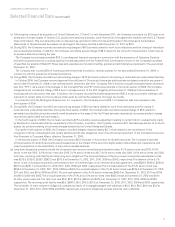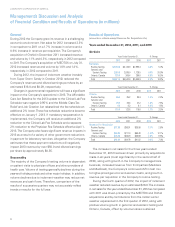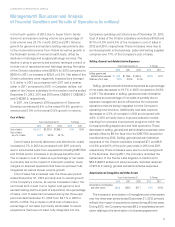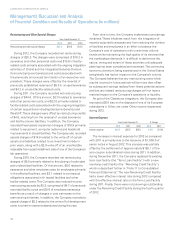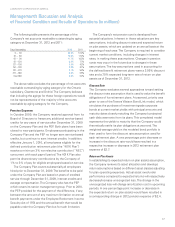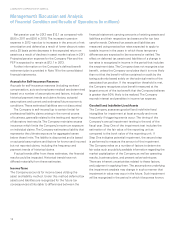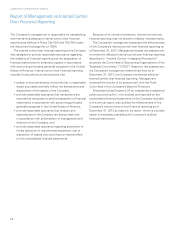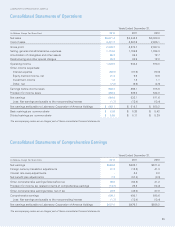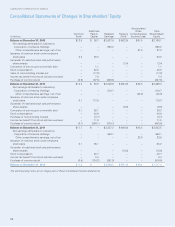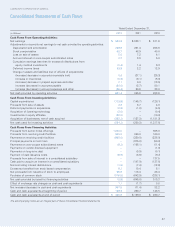LabCorp 2012 Annual Report Download - page 19
Download and view the complete annual report
Please find page 19 of the 2012 LabCorp annual report below. You can navigate through the pages in the report by either clicking on the pages listed below, or by using the keyword search tool below to find specific information within the annual report.
17
LABORATORY CORPORATION OF AMERICA
Management’s Discussion and Analysis
of Financial Condition and Results of Operations (in millions)
The following table presents the percentage of the
Company’s net accounts receivable outstanding by aging
category at December 31, 2012 and 2011:
Days Outstanding 2012 2011
0 – 30 48.9% 51.2%
31 – 60 18.6% 17.2%
61 – 90 11.7% 10.2%
91 – 120 6.5% 7.7%
121 – 150 3.9% 4.2%
151 – 180 3.3% 3.1%
181 – 270 6.1% 5.3%
271 – 360 0.8% 0.8%
Over 360 0.2% 0.2%
The above table excludes the percentage of net accounts
receivable outstanding by aging category for the Ontario
subsidiary, Clearstone and Orchid. The Company believes
that including the agings for these foreign operations would
not be representative of the majority of the accounts
receivable by aging category for the Company.
Pension Expense
In October 2009, the Company received approval from its
Board of Directors to freeze any additional service-based
credits for any years of service after December 31, 2009
on the Company Plan and the PEP. Both plans have been
closed to new participants. Employees participating in the
Company Plan and the PEP no longer earn service-based
credits, but continue to earn interest credits. In addition,
effective January 1, 2010, all employees eligible for the
defined contribution retirement plan (the “401K Plan”)
receive a minimum 3% non-elective contribution (“NEC”)
concurrent with each payroll period. The 401K Plan also
permits discretionary contributions by the Company of
1% to 3% of pay for eligible employees based on service.
The Company Plan covers substantially all employees
hired prior to December 31, 2009. The benefits to be paid
under the Company Plan are based on years of credited
service through December 31, 2009, interest credits and
average compensation. The Company also has the PEP
which covers its senior management group. Prior to 2010,
the PEP provided for the payment of the difference, if any,
between the amount of any maximum limitation on annual
benefit payments under the Employee Retirement Income
Security Act of 1974 and the annual benefit that would be
payable under the Company Plan but for such limitation.
The Company’s net pension cost is developed from
actuarial valuations. Inherent in these valuations are key
assumptions, including discount rates and expected return
on plan assets, which are updated on an annual basis at the
beginning of each year. The Company is required to consider
current market conditions, including changes in interest
rates, in making these assumptions. Changes in pension
costs may occur in the future due to changes in these
assumptions. The key assumptions used in accounting for
the defined benefit retirement plans were a 3.95% discount
rate and a 7.0% expected long-term rate of return on plan
assets as of December 31, 2012.
Discount Rate
The Company evaluates several approaches toward setting
the discount rate assumption that is used to value the benefit
obligations of its retirement plans. At year-end, priority was
given to use of the Towers Watson Bond:Link model, which
simulates the purchase of investment-grade corporate
bonds at current market yields with principal amounts and
maturity dates closely matching the Company’s projected
cash disbursements from its plans. This completed model
represents the yields to maturity that the Company could
theoretically settle its plan obligations at year end. The
weighted-average yield on the modeled bond portfolio is
then used to form the discount rate assumption used for
each retirement plan. A one percentage point decrease or
increase in the discount rate would have resulted in a
respective increase or decrease in 2012 retirement plan
expense of $2.7.
Return on Plan Assets
In establishing its expected return on plan assets assumption,
the Company reviews its asset allocation and develops
return assumptions based on different asset classes adjusting
for plan operating expenses. Actual asset over/under
performance compared to expected returns will respectively
decrease/increase unrecognized loss. The change in the
unrecognized loss will change amortization cost in upcoming
periods. A one percentage point increase or decrease in
the expected return on plan assets would have resulted in
a corresponding change in 2012 pension expense of $2.4.


